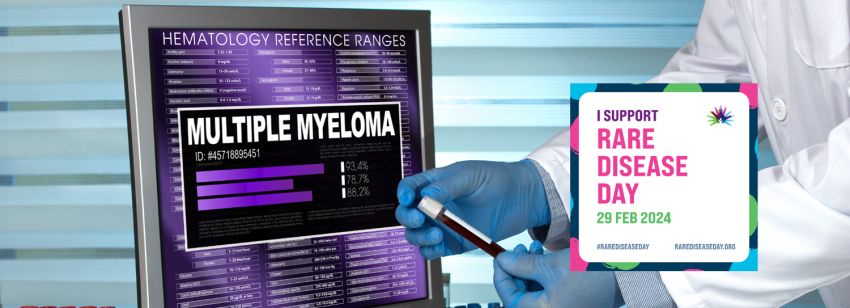Multiple myeloma
When bone marrow becomes the enemy
The complexity of multiple myeloma: pathogenesis and symptoms
During the course of the disease, genetic changes occur in plasma cells, leading to uncontrolled proliferation of degenerated and malignant plasma cells (so-called myeloma cells) that overgrow the bone marrow due to disrupted proliferation control. This results in the displacement of other blood-forming stem cells, inhibition of bone-building cells (osteoblasts), and uncontrolled production of antibodies or antibody fragments from the originating cells.
The risk of developing the disease significantly increases with age, with the median age of onset being 72 years for men and 74 years for women. In Germany, approximately 6,710 new cases are diagnosed each year. The most common symptoms include bone pain, fractures without trauma, chronic fatigue due to anemia, and increased susceptibility to infections. Although multiple myeloma is formally considered a single disease, the genetic background and clinical presentation can be highly heterogeneous.
Therapeutic approaches
The treatment of multiple myeloma has made significant progress in recent years. The therapy depends on various factors, including the stage of the disease, disease burden, and individual patient factors. Established treatment options include chemotherapy, radiation therapy, autologous stem cell transplantation, and combination therapies consisting of proteasome inhibitors, immunomodulators, steroids, as well as individualized therapies that specifically target cancer cells. After successful initial treatment, relapse of the disease is characteristic for the course of multiple myeloma. New approaches such as immunotherapy with monoclonal antibodies against CD38, bispecific antibodies, or autologous CAR-T cell therapies have expanded the therapeutic spectrum and significantly improved the prognosis. A permanent cure is still not possible, but especially with developments in the field of gene and cell therapies, there is justified hope for the future: the relative 5-year survival rates are already over 50%.
Oncology drugs are under special scrutiny in the current and upcoming period because, due to the difficult financial situation of the German health insurance system, oncology drugs are perceived as particularly cost-driving, and starting from 2025, they will have to undergo the EU HTA regulation alongside ATMPs as the first medicines. SKC, as Market Access Special Forces, supports pharmaceutical manufacturers in successfully introducing new drugs for rare diseases to the German market and thus improving the care of affected patients. Therefore, in this blog series for Rare Disease Day, we report on selected rare diseases to raise awareness and perception of them.
Sources:
- Krebs in Deutschland für 2019/2020, Robert Koch-Institut, 2023.
- Onkopedia, Multiples Myelom, accessed 15.02.2024


